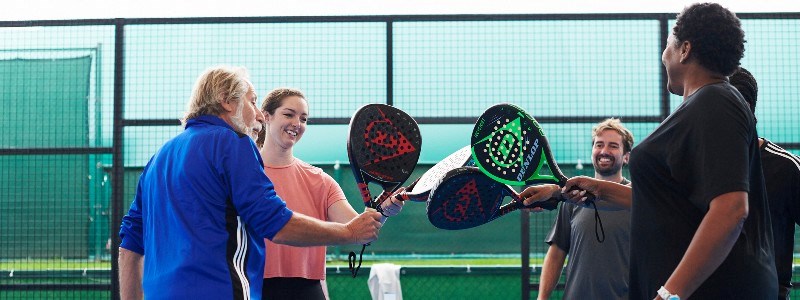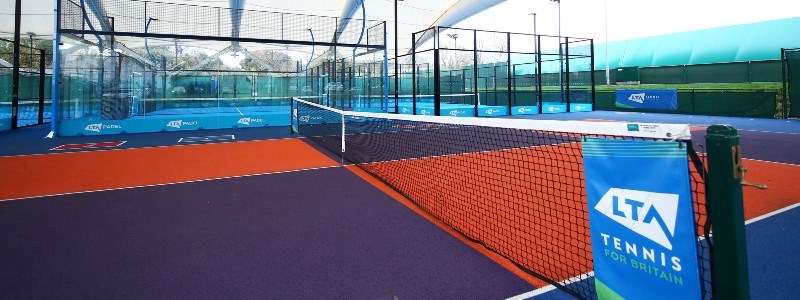
Padel in 2021: how Britain is embracing one of the world’s fastest growing sports
• 4 MINUTE READ
2021 has been a significant milestone year in the history of padel in Britain, with new courts being built around the country enabling thousands more people to have a go at what is fast becoming one of the world’s new favourite sports.
Here we hear from LTA Head of Padel, Tom Murray, looking at how the sport has developed and what is to come next year and beyond…
The background
Although considered a relatively new sport, padel has been around in Britain for longer than you might think. The British Padel Association was founded 29 years ago by a group of passionate British expats seeking to compete in the 1992 World Padel Championships, but it is only really in recent years it has started to make its exciting mark on the British sporting landscape.
In 2019, when there were just over 50 padel courts in Britain, the LTA announced it would integrate British Padel into the organisation’s day-to-day operations, and in November last year it became the National Governing Body for padel after Sport England, Sport Scotland and Sport Wales officially recognised the sport as a discipline of tennis.
The nature of padel is that it is fun, flexible and easy to play. The strategic move to bring padel under its operations aligned to the LTA’s vision to open up tennis and find new ways to grow participation, and integrating it into the LTA provided an immediate platform to facilitate the organic growth of the sport.
Since then, courts and players in Britain has grown exponentially and the landscape for padel in Britain at the end of 2021 is in a very different place.
“Growing a minority sport essentially from scratch in a country that loves its mainstream sports is a challenging task”, says Murray. “To drive that, we put in place a padel development plan to outline what needed to be done to help scale up the sport. This past year has all been about us building the game, with a primary focus on developing the overall infrastructure of the sport – the number of padel courts, a workforce, and a structured player pathway.”
New heights for padel courts and participation
Murray says that infrastructure presents the biggest opportunity to continue the growth of padel, but it also provides the main obstacle.
“The demand for courts, in 2021 and moving into 2022, is huge, which is the main driver of growing participation in padel.
There are now just shy of 150 padel courts in Britain, spread across 66 venues including tennis clubs, as well as leisure partners and padel only operators, while the latest participation data shows there are now 89,000 active players, with monthly participation around 15,000.
“The pandemic has interfered greatly with projected growth for 2021, with the planning process for projects affecting the delivery of many of the courts we anticipated being delivered this year.
“Our target for 2022 is to add another 100 courts. As highlighted within the Padel Development Plan this will mainly be achieved through organic growth e.g. within tennis venues helping to grow padel sustainably, however new sectors including padel only operators will also play a key role in this next phase”, says Murray.
“Given the stage of development we are at in this country versus padel on the continent, participation numbers are healthy, but are also reflective of the number of courts available. In the Netherlands, for example, there are currently 600 courts and a monthly participation player base of 100,000, which helps to demonstrate the potential that exists for continued growth.”
Integrating padel into tennis venues
One part of the surge in padel participation that has been seen this year has been several existing tennis venues integrating padel into their membership offerings, using the LTA Quick Access Loan Scheme to successfully grow and improve their venue.
“Building padel courts alongside existing tennis courts, creating new, modern facilities, helps in bringing new people into tennis, generating more interest and involvement in the sport as a whole”, says Murray.
“This is an approach we have put in place at the National Tennis Centre too, allowing us to demonstrate how incorporating padel courts alongside tennis facilities can successfully work.”
An example of a club that has done this effectively this year is East Gloucestershire. With significant interest in padel coupled with land availability, the club decided to convert one disused court into three floodlit padel courts. The project cost £250,000, with 50% funded by the club and 50% secured via the LTA’s interest-free Quick Access Loan Scheme.
Sundridge Park in Bromley have also successfully integrated padel into their venue offering, creating a new opportunity for existing members as well as entice new members and widening the demographic of players at their venue.
Developing the workforce
Alongside infrastructure growth, developing and upskilling the workforce is another critical aspect of the padel development plan. A significant step taken this year saw the creation of the padel coaching pathway with the launch of the LTA’s CPD on ‘Introduction to Padel Coaching’, as well as the training up of padel tutors.
“Moving into 2022 the padel coaching qualifications will be launched and we will be liaising with our Coach Development Centre network for delivery” explains Murray.
“Whilst the sport is still in its infancy, there is the opportunity for ongoing research and consultation on what other countries have done, which will allow for a framework to be devised so that when the padel coaching plans launch, they can have the necessary impact.
“With many new people trying the sport, including a number of active tennis players, we have also introduced an online conversion course for LTA tennis officials to upskill in padel, with over 50 officials successfully becoming qualified. Next year will see the introduction of a padel referee structure, which is another crucial step in growing the padel workforce.”
Given the stage of development we are at in this country versus padel on the continent, participation numbers are healthy, but are also reflective of the number of courts available
More competitions & a structured player pathway
Crucial to encouraging people to play padel more often is providing the opportunity to compete at an appropriate level, and the developments introduced for padel competitions this year have seen record numbers take part.
“Earlier this year we introduced new grades of competition providing opportunity at local level as well as LTA Youth events and Team Challenge with 500+ junior players taking part in LTA Youth tournaments. So far this year we have delivered 83 events (47 tournaments) across 20 padel venues with over 1300 players taking part in an LTA Padel Tour event (656 men and 190 women).
“Moving into 2022, the LTA Padel Tour will provide players with more opportunity to compete than ever before with an increase in events and venues at all levels of competition, broken down by national, regional, county & local tours."
At the elite level of the sport there are eight British players currently competing on the World Padel Tour. Two women Tia Norton, Hannah Ruddick and six men; Christian Murphy, Richard Brooks, Louie Harris, Sam Jones, Ryan Wyatt, and Nikhil Mohindra. All of these players along with their GB teammates competed in this year’s European Championships in Marbella, Spain and the World Championships in Qatar.
“To ensure Britain is successful on the world stage going forward, we will be developing a Padel Performance Programme, to include scholarships for players 16+ and NTC access” added Murray.
Looking ahead…
So, what comes next? While the sport has made great strides forward in 2021, Murray is excited about the future.
“We are pleased with the progress we have made this year, especially around infrastructure and participation. It really is an exciting time for padel and it is great to now see a constant stream of new venues, players, coaches and officials coming in to the sport. Whilst we know there is much to do in 2022, a lot of which is integral to the future of padel in Britain, it’s a great journey to be a part of. We’d like to thank everyone who has played a role in growing padel over the last 12 months and are now looking forward to what is to come next year.”
Find our more about Padel and how you can get involved.








